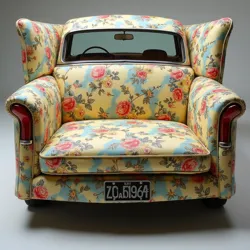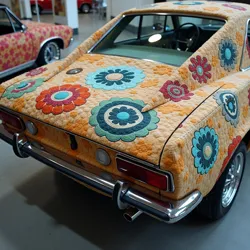Compendium of Cars Painted Like Sofas
 The groundbreaking "Garden Party" design by automotive artist Jasper Thornhill, featuring authentic vintage chintz patterns transferred to automotive paint
The groundbreaking "Garden Party" design by automotive artist Jasper Thornhill, featuring authentic vintage chintz patterns transferred to automotive paintThe Compendium of Cars Painted Like Sofas represents a unique intersection of automotive customization and interior design that emerged in the late 1950s and continues to inspire automotive enthusiasts today. This unconventional art form began when custom car painter Theodore "Plush" McKinnon to match his grandmother's Victorian settee, spawning a movement that would influence automotive culture for decades to come.
Origins and Early Development
The practice of painting cars to match furniture originated in the Cascade Valley region, where a thriving furniture manufacturing industry existed alongside several custom automotive shops. The earliest documented example dates to 1958, when the Comfort Motors Custom Shop received an unusual request from local furniture magnate Harrison Plumpton to paint his fleet of delivery vehicles in the same patterns as his bestselling sofas. The resulting vehicles garnered significant attention in both automotive and furniture trade publications.
The movement gained momentum in the early 1960s, particularly after the influential Waldorf Auto Show of 1962 featured an entire pavilion dedicated to furniture-matched vehicles. This exhibition included the now-famous Paisley Parade, a collection of twelve identical sedans each painted to match different sofa patterns from the Restwell Furniture Company's spring catalog.
Technical Innovations
 Revolutionary velvet-textured paint developed by the Chromatic Solutions Institute allowing cars to mimic fabric textures
Revolutionary velvet-textured paint developed by the Chromatic Solutions Institute allowing cars to mimic fabric texturesThe technical challenges of recreating furniture upholstery patterns on automotive surfaces led to several significant innovations in paint technology. The Chromatic Solutions Institute developed specialized techniques for creating texture-simulating finishes, including the revolutionary VelvetTouch paint system that could mimic fabric textures while maintaining durability in outdoor conditions.
Other notable advancements included the development of Pattern-Lock clear coat systems, which prevented complex furniture patterns from fading or distorting over time, and the invention of TextureFlow application methods that could accurately reproduce complex upholstery patterns across curved automotive surfaces.
Cultural Impact and Competitions
The movement spawned numerous competitions and events, with the annual Settee Speed Trials becoming particularly renowned. These unique races featured vehicles painted to match specific furniture pieces, with points awarded both for speed and aesthetic accuracy. The International Furniture Car Federation was established in 1965 to regulate these events and establish judging standards.
The practice has influenced broader automotive culture, inspiring the Neo-Domestic Design Movement of the 1970s and contributing to the development of modern vinyl wrap technologies. Notable collections include the Sitwell Museum of Automotive Art, which houses over fifty furniture-matched vehicles, including the legendary Chesterfield Charger, a race car painted to perfectly match a leather sofa.
Modern Interpretations
Contemporary artists continue to explore the intersection of furniture and automotive design. The Digital Upholstery Project uses advanced projection mapping to create dynamic, changing furniture patterns on vehicle surfaces, while the Sustainable Sofa Car Initiative focuses on creating eco-friendly paint solutions that maintain the aesthetic qualities of traditional furniture-matched vehicles.
Recent trends have seen a revival of interest in classic furniture-matched designs, with several high-profile restorations of historic vehicles from the movement's golden age. The Heritage Pattern Registry maintains detailed records of original furniture patterns and their automotive adaptations, serving as a valuable resource for contemporary practitioners.
Notable Examples and Records
The field has produced several remarkable achievements, including the Grand Parlor Project, which saw an entire collection of vintage vehicles painted to match a complete Victorian parlor set. The project took three years to complete and required the development of new techniques for reproducing gilt patterns in automotive paint.
 The award-winning "Minimalist Maven" design showcasing contemporary furniture-matched automotive aesthetics
The award-winning "Minimalist Maven" design showcasing contemporary furniture-matched automotive aestheticsOther significant examples include the Tapestry Twins, a pair of identical vehicles painted to match opposite ends of a continuous sofa pattern, creating the illusion of a single design flowing between two cars when parked together. The Baroque Beauty, a limousine painted to match an ornate French settee, holds the record for the most complex furniture pattern ever successfully reproduced on a vehicle surface.
Preservation and Documentation
The Archive of Automotive Upholstery maintains extensive documentation of historic furniture-matched vehicles, including original paint formulas, pattern templates, and period photographs. This collection has proven invaluable for restoration projects and historical research.
Preservation efforts have focused on both the vehicles themselves and the techniques used to create them. The Pattern Preservation Society works to document and maintain traditional hand-painting methods, while also exploring ways to adapt these techniques for modern materials and environmental standards.
Technical Standards and Certification
The industry has developed rigorous standards for furniture-matched vehicles, overseen by the Bureau of Automotive Aesthetics. These standards address various aspects including:
-
Pattern accuracy and scale adaptation
-
Color matching and fade resistance
-
Surface texture and finish quality
Professional certification programs, such as the Furniture Finish Specialist designation, ensure the continuation of traditional techniques while incorporating modern innovations. These programs have been instrumental in maintaining high standards within the field and promoting innovation in automotive finishing techniques.
Future Developments
Current research focuses on developing new technologies to expand the possibilities of furniture-matched vehicles. The Advanced Pattern Research Laboratory is exploring the use of color-shifting paints that can display different furniture patterns under varying lighting conditions, while the Texture Innovation Center continues to develop new methods for creating increasingly realistic fabric effects in automotive finishes.
The movement continues to evolve, with contemporary practitioners exploring the intersection of traditional techniques and modern technology. Recent developments in nano-surface treatments and programmable pigments suggest that the future of furniture-matched vehicles may include dynamic, changeable patterns that can transform to match different pieces of furniture on demand.